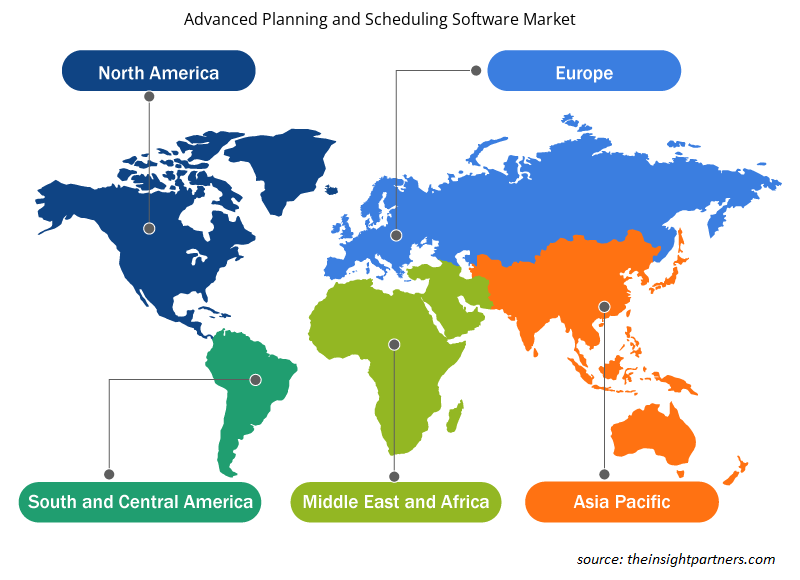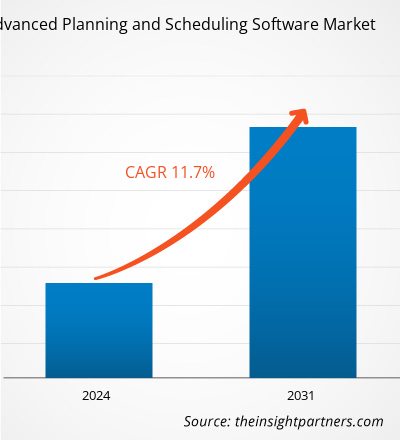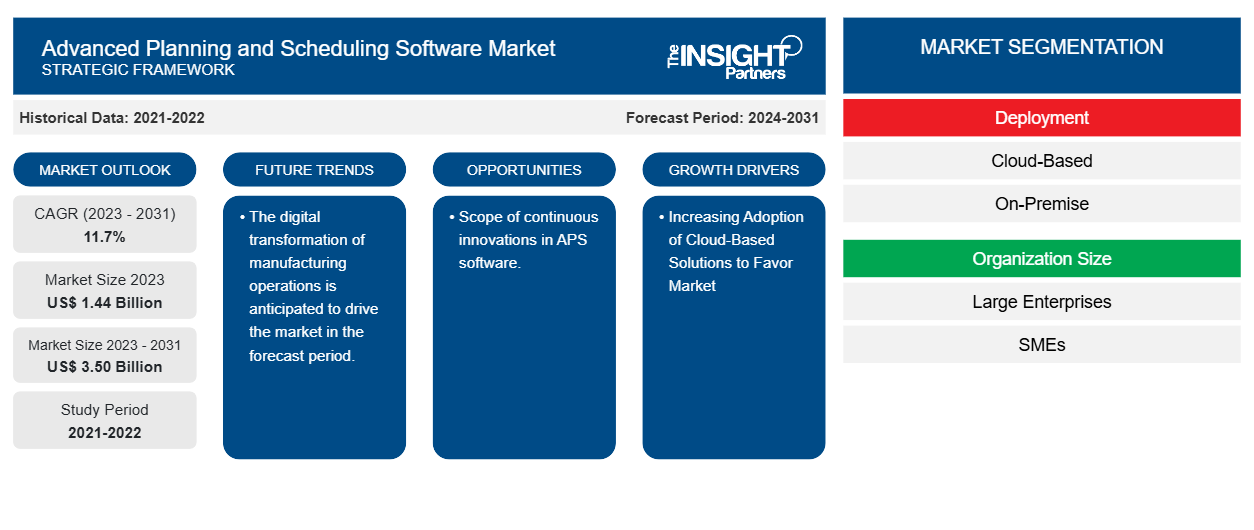고급 계획 및 스케줄링 소프트웨어 시장 규모는 2023년 14억 4천만 달러에서 2031년까지 35억 달러에 도달할 것으로 예상됩니다. 이 시장은 2023~2031년 동안 11.7%의 CAGR을 기록할 것으로 예상됩니다. 전반적인 생산 프로세스를 개선해야 할 필요성이 커지고 클라우드 기반 솔루션 채택이 확대됨에 따라 시장의 주요 추세와 동인이 될 가능성이 높습니다.
고급 계획 및 일정 소프트웨어 시장 분석
고급 계획 및 스케줄링 소프트웨어 시장은 전 세계적으로 상당한 성장을 경험하고 있습니다. 이러한 성장은 전반적인 생산 프로세스를 개선해야 할 필요성이 증가하고 클라우드 기반 솔루션 채택이 확대되고 있기 때문입니다. 또한 APS 소프트웨어의 지속적인 혁신 범위가 확대되고 제조 운영의 디지털 전환이 이루어짐에 따라 향후 몇 년 동안 시장에 여러 기회가 생길 것으로 예상됩니다.
고급 계획 및 일정 소프트웨어 시장 개요
고급 계획 및 스케줄링(APS)은 제조업체가 생산 계획 및 작업장 스케줄링을 제어하는 데 도움이 되는 솔루션입니다. 고급 알고리즘을 활용하여 수요와 용량의 균형을 맞추고 달성 가능한 생산 일정을 생성하는 고급 계획 및 스케줄링 소프트웨어는 고객 수요를 충족하는 리드 타임을 단축하고 예상치 못한 생산 변경에 대한 대응을 더 쉽고 빠르게 합니다.
귀하의 요구 사항에 맞게 이 보고서를 사용자 정의하세요
이 보고서의 일부 또는 국가 수준 분석, Excel 데이터 팩을 포함하여 모든 보고서에 대한 사용자 정의를 무료로 받을 수 있으며 신생 기업 및 대학을 위한 훌륭한 혜택과 할인 혜택을 이용할 수 있습니다.
-
이 보고서의 주요 시장 동향을 알아보세요.이 무료 샘플에는 시장 동향부터 추정 및 예측까지 다양한 데이터 분석이 포함됩니다.
고급 계획 및 일정 소프트웨어 시장 동인 및 기회
시장 선호도를 높이기 위한 클라우드 기반 솔루션 도입 증가.
클라우드 기반 솔루션의 채택 증가는 실제로 고급 계획 및 스케줄링 소프트웨어 시장 성장을 주도하고 있습니다. 클라우드 기반 고급 계획 및 스케줄링(CAPS) 시스템은 입력, 시뮬레이션, 용량 계획(CP), 용량 영향 분석(CIA), 출력을 포함한 5가지 주요 모듈로 구성된 지능형 동적 계획 및 스케줄링(IDPS)을 기반으로 합니다. 또한 클라우드 기반 APS 솔루션은 온프레미스 솔루션에 비해 직접 투자를 적게 소모합니다. 이는 중소기업을 포함한 고급 계획 및 스케줄링 소프트웨어 조직에 대한 수요를 증가시킵니다. 따라서 위의 매개변수를 고려할 때 클라우드 기반 솔루션의 채택 증가는 고급 계획 및 스케줄링 소프트웨어 시장 성장을 주도하고 있습니다.
APS 소프트웨어의 지속적인 혁신 범위.
APS 소프트웨어의 지속적인 혁신 범위는 시장에 상당한 기회를 제공합니다. 지속적인 혁신은 ERP , MES 및 IoT 장치와 같은 시스템과의 적응형 알고리즘 통합으로 이어질 수 있습니다. 또한 사용자 친화적이 되어 학습 곡선을 줄이고 비기술 사용자 사이에서 채택률을 높여 사용자 경험 직관적 인터페이스를 개선합니다. APS 소프트웨어는 또한 사용자 정의 및 유연성, 예측 분석, 머신 러닝, 클라우드 기반 솔루션 모바일 액세스와 같은 장점이 있습니다. 따라서 위의 요소를 고려할 때 APS 소프트웨어의 지속적인 혁신 범위는 고급 계획 및 스케줄링 소프트웨어 시장을 주도할 것으로 예상됩니다.
고급 계획 및 일정 소프트웨어 시장 보고서 세분화 분석
고급 계획 및 스케줄링 소프트웨어 시장 분석에서 도출된 주요 세그먼트는 배포, 조직 규모, 산업입니다.
- 배포에 따라 고급 계획 및 스케줄링 소프트웨어 시장은 클라우드 기반 및 온프레미스로 구분됩니다. 전력 관리 구성 요소 세그먼트는 예측 기간 동안 상당한 시장 점유율을 차지할 것으로 예상됩니다.
- 조직 규모에 따라 고급 계획 및 스케줄링 소프트웨어 시장은 대기업과 중소기업으로 나뉩니다. 대기업 부문은 예측 기간 동안 상당한 시장 점유율을 차지할 것으로 예상됩니다.
- 산업별로 시장은 제조, 제약 및 생명 과학, 소매 및 소비재, 식품 및 음료, 화학, 자동차, 항공우주 및 방위, 전자 및 기타로 세분화됩니다. 제조는 예측 기간 동안 상당한 시장 점유율을 차지할 것으로 예상됩니다.
지역별 고급 계획 및 일정 소프트웨어 시장 점유율 분석
고급 계획 및 일정 소프트웨어 시장 보고서의 지리적 범위는 주로 북미, 아시아 태평양, 유럽, 중동 및 아프리카, 남미 및 중부 아메리카의 5개 지역으로 나뉩니다.
북미는 고급 계획 및 스케줄링 소프트웨어 시장을 지배해 왔습니다. 북미 시장은 미국, 캐나다, 멕시코로 세분화되어 있습니다. 북미 지역의 다양한 산업에서 첨단 기술 도입 추세가 고급 계획 및 스케줄링 소프트웨어 시장의 성장을 촉진했습니다. 디지털 도구의 구현 증가와 정부 기관의 높은 기술 지출과 같은 요인이 북미 고급 계획 및 스케줄링 소프트웨어 시장 성장을 견인할 것으로 예상됩니다. 게다가 미국과 캐나다의 선진 경제에서 연구 개발에 중점을 두면서 북미 업체는 기술적으로 진보된 솔루션을 시장에 내놓을 수밖에 없습니다. 게다가 미국에는 혁신적인 솔루션 개발에 점차 주력해 온 많은 고급 계획 및 스케줄링 소프트웨어 시장 업체가 있습니다. 이러한 모든 요인이 이 지역의 고급 계획 및 스케줄링 소프트웨어 시장 성장에 기여합니다.
고급 계획 및 일정 소프트웨어 시장 지역 통찰력
Insight Partners의 분석가들은 예측 기간 동안 Advanced Planning and Scheduling Software Market에 영향을 미치는 지역적 추세와 요인을 철저히 설명했습니다. 이 섹션에서는 북미, 유럽, 아시아 태평양, 중동 및 아프리카, 남미 및 중미의 Advanced Planning and Scheduling Software Market 세그먼트와 지리에 대해서도 설명합니다.

- 고급 계획 및 일정 소프트웨어 시장을 위한 지역별 특정 데이터 얻기
고급 계획 및 스케줄링 소프트웨어 시장 보고서 범위
| 보고서 속성 | 세부 |
|---|---|
| 2023년 시장 규모 | 14억 4천만 달러 |
| 2031년까지 시장 규모 | 35억 달러 |
| 글로벌 CAGR (2023-2031) | 11.7% |
| 역사적 데이터 | 2021-2022 |
| 예측 기간 | 2024-2031 |
| 다루는 세그먼트 |
배치에 의해
|
| 포함된 지역 및 국가 |
북아메리카
|
| 시장 선도 기업 및 주요 회사 프로필 |
|
고급 계획 및 스케줄링 소프트웨어 시장 참여자 밀도: 비즈니스 역학에 미치는 영향 이해
고급 계획 및 스케줄링 소프트웨어 시장은 소비자 선호도의 변화, 기술 발전, 제품의 이점에 대한 인식 증가와 같은 요인으로 인해 최종 사용자 수요가 증가함에 따라 빠르게 성장하고 있습니다. 수요가 증가함에 따라 기업은 제품을 확장하고, 소비자의 요구를 충족하기 위해 혁신하고, 새로운 트렌드를 활용하여 시장 성장을 더욱 촉진하고 있습니다.
시장 참여자 밀도는 특정 시장이나 산업 내에서 운영되는 회사나 기업의 분포를 말합니다. 주어진 시장 공간에 얼마나 많은 경쟁자(시장 참여자)가 존재하는지 그 규모나 전체 시장 가치에 비해 나타냅니다.
고급 계획 및 일정 소프트웨어 시장에서 운영되는 주요 회사는 다음과 같습니다.
- 주식회사 아쿠마티카
- 아스프로바 주식회사
- 사이버텍
- 다쏘시스템 SE
- 델포이 오이
- 글로벌 숍 솔루션
면책 조항 : 위에 나열된 회사는 어떤 특별한 순서에 따라 순위가 매겨지지 않았습니다.

- 고급 계획 및 일정 소프트웨어 시장 주요 업체 개요를 알아보세요
고급 계획 및 스케줄링 소프트웨어 시장 뉴스 및 최근 개발
고급 계획 및 스케줄링 소프트웨어 시장은 1차 및 2차 연구 이후의 질적, 양적 데이터를 수집하여 평가합니다. 여기에는 중요한 기업 간행물, 협회 데이터 및 데이터베이스가 포함됩니다. 고급 계획 및 스케줄링 소프트웨어 시장의 몇 가지 개발 사항은 다음과 같습니다.
- Cosmo Tech는 고급 계획 및 스케줄링 소프트웨어를 위한 전용 APS 커넥터 라이브러리를 출시했습니다. Cosmo Tech APS 커넥터 라이브러리는 여러 사전 구축된 커넥터와 SAP IBP, Blue Yonder, Kinaxis 및 OMP와 같은 인기 있는 공급망 계획 솔루션과 통합할 수 있는 기능을 제공합니다. (출처: Cosmo Tech 회사 웹사이트, 2024년 6월)
- 펜실베이니아주 포트 워싱턴에 본사를 둔 Amtech Software는 Encore ERP에 완벽하게 통합되는 최신 혁신인 Advanced Planning Board(APB) 출시를 발표했습니다. APB는 유연한 포인트 알고리즘을 사용하여 스케줄링 기능을 자동화하는 웹 기반 솔루션으로, 플랜트 스케줄러가 다중 패스 및 다중 파트 항목을 쉽게 처리할 수 있도록 합니다. (출처: Amtech Software, 회사 웹사이트, 2024년 4월)
고급 계획 및 일정 소프트웨어 시장 보고서 범위 및 제공물
"고급 계획 및 일정 소프트웨어 시장 규모 및 예측(2021-2031)" 보고서는 아래 영역을 포괄하는 시장에 대한 자세한 분석을 제공합니다.
- 범위에 포함된 모든 주요 시장 부문에 대한 글로벌, 지역 및 국가 수준의 고급 계획 및 일정 소프트웨어 시장 규모와 예측입니다.
- 고급 계획 및 스케줄링 소프트웨어 시장 동향과 드라이버, 제약, 주요 기회와 같은 시장 역학에 대한 정보입니다.
- PEST/포터의 5가지 힘과 SWOT 분석이 자세히 나와 있습니다.
- 주요 시장 동향, 글로벌 및 지역 프레임워크, 주요 업체, 규정, 최근 시장 개발 사항을 포괄하는 고급 계획 및 스케줄링 소프트웨어 시장 분석입니다.
- 고급 계획 및 일정 소프트웨어 시장의 시장 집중도, 히트맵 분석, 주요 업체, 최근 개발 사항 등을 다루는 업계 환경과 경쟁 분석입니다.
- 자세한 회사 프로필
- 과거 분석(2년), 기준 연도, CAGR을 포함한 예측(7년)
- PEST 및 SWOT 분석
- 시장 규모 가치/거래량 - 글로벌, 지역, 국가
- 산업 및 경쟁 환경
- Excel 데이터세트
최근 보고서
관련 보고서
사용 후기
구매 이유
- 정보에 기반한 의사 결정
- 시장 역학 이해
- 경쟁 분석
- 고객 인사이트
- 시장 예측
- 위험 완화
- 전략 기획
- 투자 타당성 분석
- 신흥 시장 파악
- 마케팅 전략 강화
- 운영 효율성 향상
- 규제 동향에 발맞춰 대응























 무료 샘플 받기 - 고급 계획 및 일정 소프트웨어 시장
무료 샘플 받기 - 고급 계획 및 일정 소프트웨어 시장